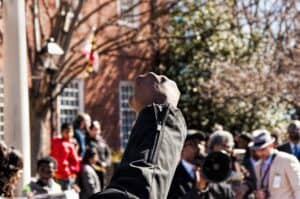 Ministry volunteers and secondary trauma
Ministry volunteers and secondary trauma
by Nita Belles
As I walked along Bourbon Street in New Orleans a couple of nights before the 2013 Super Bowl, my heart broke repeatedly. Young teen girls were paraded in and out of strip clubs while their pimps talked on cell phones, arranging “dates” for their victims, who would be forced to turn over every dime “earned” for providing sexual services.
My mind rehearsed the horrific abuse and coercion suffered by these children at the hands of their traffickers. Psychologically and sometimes physically enslaved, valued only as a commodity capable of putting cash in the traffickers’ pockets, girls caught up in the vortex of modern slavery are possibly the most traumatic sight that an anti-trafficking volunteer can witness.
This is the face of sex trafficking, and it’s in my backyard and yours.
My team was partnering with local law enforcement, and while many recoveries were taking place, my heart grieved that I couldn’t do more. I tried to make eye contact with victims, to entice them to talk to me, knowing there were services available and yet also knowing that due to the abuse and traumatic bonding that victims experience with their traffickers, very few would be able to receive—or even believe that they wanted—help. Due to the warm weather and socially accepted vulgar atmosphere on Bourbon Street, I saw more blatant evidence of sex trafficking there than I had seen at any previous Super Bowl.
As I left New Orleans the following day, my mind raced with the scenes I had witnessed. There were too many victims to possibly recover in our joint efforts with law enforcement. In spite of our hard work, young girls and boys were being led as sheep to a torturous slaughter.
In the weeks following the Super Bowl, these same images of victims haunted me as I tried to sleep. I found myself driven like never before to do more, more, more…I wanted to recover more victims, network with more service providers to offer them more opportunities for true help. Networking with legislators and others with the power to change laws took on new meaning. I was more passionate than ever about working with law enforcement and ramped up my presentations to them and others.
But at the end of each day I found myself beyond exhausted—physically, emotionally and spiritually. It seemed that although everyone wanted only a small piece of me, my overachieving self was driven to give each person my all. An interior monologue of self-shaming became the soundtrack of my days, as I never seemed to be able to do enough. My desire to stop the atrocity of sex trafficking pushed me to answer “one more” email, write “one more” paper, do “one more” presentation. I buried myself in the abundance of work available to me, finding satisfaction each time I was able to help someone but seeing that satisfaction quickly fade as I moved on to the next task at hand. None of this in itself was wrong, but rather than being fulfilled and joyful in my work I was weary.
Although my work is often stressful, I was aware of experiencing an inordinate amount of stress, flashbacks, and even some “triggers” that caused me to panic. I began researching emotional rawness and realized that the label for the misery I was enduring is secondary trauma. Some related conditions of Secondary Trauma Syndrome (STS) include:
• Compassion fatigue: Spiritual, emotional, and physical depletion associated with caring for others in significant emotional pain and physical distress;1 sometimes used interchangeably with Secondary Traumatic Stress (STS).
• Vicarious trauma: Changes in the inner experience of a therapist or advocate as a result of empathetic engagement with a traumatized client.2 Symptoms may include disturbances in the professional’s cognitive behavioral approach concerning their ability to trust and feel safe or in control, and it may even affect their level of self-esteem and ability to experience intimacy.
• Burnout: Symptoms include emotional exhaustion, the feeling that one’s contribution is not enough, and an emotional distancing from one’s feelings or the needs of one’s client. It is related to occupational stress or overload and is not necessarily related to exposure to traumatic stress.
I recognized some of these symptoms in myself and knew I needed to do something both to continue in the fight and to heed the advice I’d so often given to others: “I have it on good authority that you are just as precious and valuable to God as those you are trying to help.”
“I have it on good authority that you are just as precious and valuable to God as those you are trying to help.”
What do we do upon recognizing symptoms of secondary trauma in ourselves? How do we go about taking the necessary steps towards recovering our emotional and physical health? My research revealed that many of the remedies center on a supportive workplace where supervisors care for their employees, not taking work home, not working excessive hours, etc.
But none of those remedies fit my situation. As a full-time volunteer who oversees nonprofits, each on a shoestring budget, there was no supervisor to look after me. Working from my home gave me plenty of opportunity to ignore work/home boundaries. The nature of my work and my environment set me up for STS, and there was no provision for help. It was time for me to help myself in a way that was honest, transparent, and committed.
Throughout my years of working with victims of domestic violence and human trafficking, I had learned how to help them survive for the short term until they were able to connect with professional counseling. One of the things I commonly recommended to survivors was to find a safe person to talk to. Such a person was not supposed to come up with answers or solutions but simply listen to the survivor without being traumatized herself or himself by what was being said. I encouraged survivors to keep talking when things came to mind or were bothering them, as long as the talk was helping them work through it. I recommended this because often a person who is able to talk through traumatic events eventually gets to a place where the memories lose their power to debilitate the person and cease to “sting” in the same way.
So when I found myself lying awake several nights in a row thinking about someone I wished I could have helped more, or some sad situation over which I had no control, I knew I needed to find a couple of stable friends to talk to. I contacted several friends and asked their permission to talk with them confidentially, explaining to them the feelings I was experiencing and why. I was careful to check with them regularly to be sure I wasn’t just transferring my trauma to them with my confidences.
Fortunately, the more I talked the less I needed to talk. There was something about being free to express my thoughts, feelings, pain, and experiences in a nonthreatening environment that took the sting out of the memories. I also promised them that if talking things out with them didn’t work, I would seek a counselor to help me further process my emotional distress.
After a few days of spending 15-20 minutes talking to these trusted individuals, I was once again able to fall (and stay) asleep at night. I still remembered my experiences, but instead of being haunted by them and plagued by circular thinking, I was able to begin to use them to strengthen my future work.
Journaling was another self-led therapeutic activity I took on. Just as I had spoken out my feelings and distress to others, I also recorded them in a journal, allowing myself to go down rabbit trails and search my heart in conversation with the Lord.
Talking things out, journaling, and (if I had decided to pursue it) going to a therapist couldn’t empower me with enough vigor and wisdom to wipe out modern-day slavery. But my efforts at self-care did allow me to sleep, to think more clearly again, to laugh and enjoy my family and friends, and to experience meaningful work and relationships again. They also helped keep me healthy enough to continue to make a difference in fighting human trafficking. In short, they allowed me to get past my STS.
There was a time when I thought I was immune to such trauma because of my strong relationships, the structure and boundaries in my life, and my strong faith. Now I realize that STS can happen to anyone working with distressing situations, including me, if I’m not careful. Superwoman I am not, but with honest self-reflection and a commitment to self-care and accountability, it is possible not only to survive but also to thrive in anti-human trafficking work as a full-time volunteer.
Nita Belles works with top law enforcement, government officials, social services, and the medical and faith communities to combat human trafficking. The author of In Our Backyard: A Christian Perspective on Human Trafficking in the United States (2011), she is a regional director of Oregonians Against Trafficking Humans, overseeing the Central Oregon Human Trafficking Task Force.
Endnotes:
1. P. Anewalt, “Fired up or burned out? Understanding the importance of professional boundaries in home health care hospice,” (Home Healthcare Nurse, 27:10, 2009), 591-597.
2. L. A. Pearlman and K. W. Saakvitne, “Treating therapists with vicarious traumatization and secondary traumatic stress disorders” (1995), as cited in Compassion fatigue: Coping with secondary traumatic stress disorder in those who treat the traumatized, edited by Charles R. Figley (Brunner/Mazel, 1995), 150-177.


